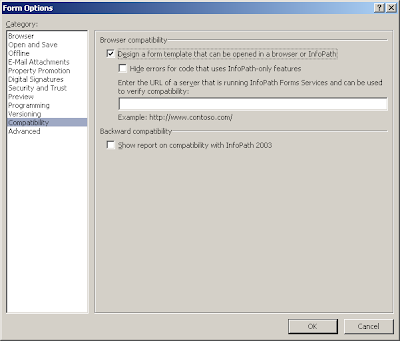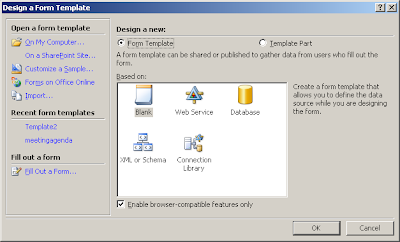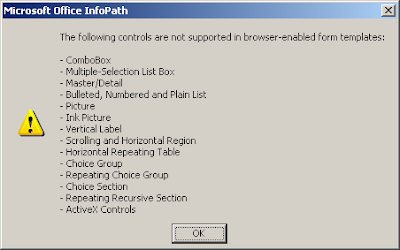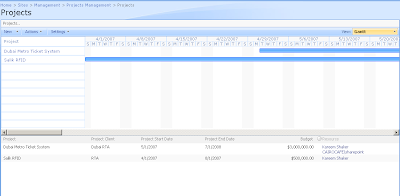InfoPath Forms Services is a new addition to both InfoPath 2007 and MOOS 2007, InfoPath 2003 served a great purpose to design forms, based on XML, that can collect users' input in easy steps, designing forms in InfoPath is a real fun, you can build very complex forms in a few minutes, InfoPath forms can interact with SQL Server, XML files, WebServices, and SharePoint List as a data source, however it's worth mentioning that one InfoPath form could have more than on data source, also InfoPath offers to embed the data inside the form itself, InfoPath 2003 offered a brilliant way to let users fill data in forms and post dta back to MOOS 2003, the biggest limitation was that the user who's filing the form should have InfoPath 2003 installed, otherwise no other way to open the form, this gave birth to
InfoPath Forms Services , it's a core feature that's shipped with Enterprise License for MOSS 2007, whereby you can design your InfoPath forms and publish to MOSS 2007, then using InfoPath Forms Services, MOSS is rendering InfoPath forms to users using browsers, so no need to have InfoPath installed anymore, however there are some limitations for the designed forms, you'll be limited by using some set of controls, these ones are renderable inside browsers, other controls are not supported by InfoPath Services, so you have to keep this in mind while desigining your forms, also you can use the design compatablity checker from InfoPath 2007, this checker checks compatablity of the designed form against InfoPath Forms Services and InfoPath 2003, you can launch it by clicking Tools -> Design Checker, but before launching it you have to set the compatablity options by clicking Tools -> Form Options, select from Category
Compatibility, you will get this dialog box:

If you plan to publish your form to MOSS 2007 InfoPath Forms Services Server, check Design a form template that can be opened in a browser or InfoPath. then click OK, then launch the design checker you will get any probable errors or warnings, resolve them and then you can publish your form, I have tried one InfoPath form and got this list of errors:
 If you check the above list you will find that the combobox is not compatible, actually there is a subtle difference between the dropdown list and combobox, in InfoPath terms, the combobox allows the user to enter items into it, if the item is not listed in the combobox items.
If you check the above list you will find that the combobox is not compatible, actually there is a subtle difference between the dropdown list and combobox, in InfoPath terms, the combobox allows the user to enter items into it, if the item is not listed in the combobox items.
For the full list of controls compatibility in InfoPath Forms Services you can check it here
One of the cool features I like about InfoPath 2007, it can impose working in Forms Services compatibility mode, Launch InfoPath 2007, click Design a Form Template, check Enable browser-compatible features only, select the template type you want to design, from the task pane, click Controls, you will find that the toolbox is only populated with compatible controls, and all the other ones are not listed, such as Combobox, this is one of the good practices to design a browser compatible InfoPath form.

Once you click OK, and get the default template's view, view the Controls from task pane if it's not visible, you will find that all unsupported controls have been hidden and one note is written below the controls toolbox saying "Some controls have been hidden based on the current compatibility settings."

if you click this yellow note, you will get a messagebox that's listing all the controls that have been hidden to build compatible forms

Note: Template parts are not
compatible with InfoPath Forms Services, in compatibility mode all the custom controls in controls toolbox are hidden, as the template parts are not supported.
Labels: MOSS 2007

 It lets you carry out any operation you want to, with a mouse click, and also it offers dynamic preview, you can try this yourself for fonts, and changing smart art type.
It lets you carry out any operation you want to, with a mouse click, and also it offers dynamic preview, you can try this yourself for fonts, and changing smart art type.






















 RSS and Blogs
RSS and Blogs